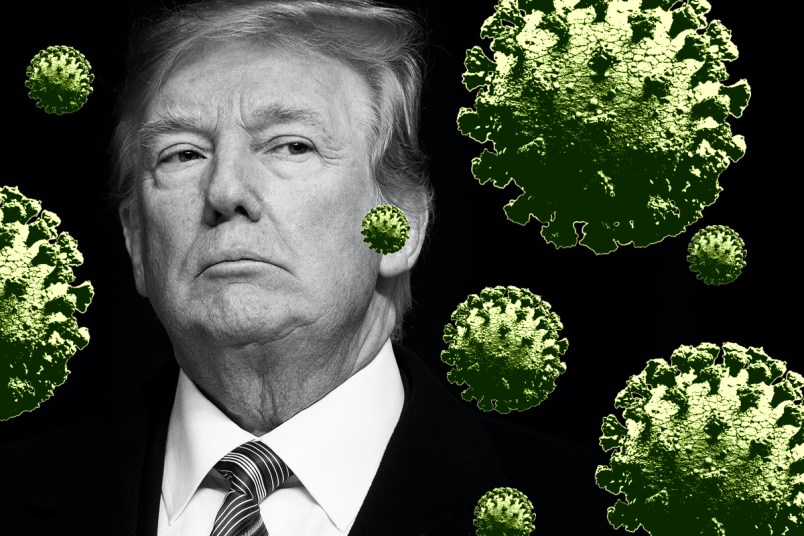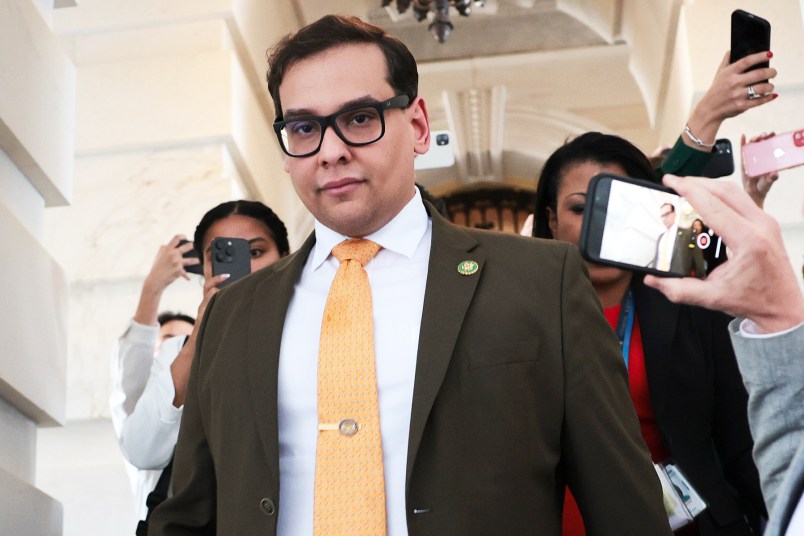President Donald Trump tested positive for COVID-19 on Thursday. And that’s about all we know for sure.
The White House and attached doctors have been cagey and nonresponsive about critical steps of the President’s illness, including when his last negative test was, when he started displaying symptoms and when exactly White House officials knew of Hope Hicks’ positive diagnosis.
Related information, like when the President was given supplemental oxygen and how dire his condition was, came out in distorted, sometimes contradictory dribs and drabs.
Still, overlaying the typical course of a COVID-19 infection on top of a timeline stitched together from press conferences, releases, tweets and reporting reveals an alarming truth: when Trump was likely at his most infectious, he was in close proximity to figures including former Vice President Joe Biden, current Vice President Mike Pence and a whole host of members of Congress. And based on the usual trajectory of the disease, Trump could still be infectious to the people around him now.
Monday, September 28: Presymptomatic and Infectious
Trump was definitely symptomatic on Thursday, Oct. 1, according to his doctors, and possibly before that. The average incubation period for the virus after exposure but before symptoms manifest is four to five days. If Thursday was when his symptoms appeared for the first time, Trump would have been infected by the start of the week, with the viral load building up in his body. A COVID-19-infected person can spread the disease up to 72 hours before experiencing symptoms.
What Trump was doing Monday:
- Trump surveyed a truck on the South Lawn of the White House with two members of Congress and representatives from manufacturer Lordstown Motors.
- Trump held a Rose Garden event on test distribution attended by Pence, members of Congress and state officials.
Tuesday, September 29: Presymptomatic and Highly Infectious
Emerging research shows that infected people are most likely to spread the disease in the 48 hours before symptoms manifest.
What Trump was doing Tuesday:
- He and his entourage — including Hope Hicks, campaign manager Bill Stepien and first lady Melania Trump, all of whom have since tested positive — traveled to Cleveland for the first presidential debate.
- Many of the Trump camp did not wear masks in the debate hall or at the hotel where they checked in beforehand, a violation of both venues’ mask mandates.
- Trump debated on stage with Biden, though the men were over 12 feet apart and did not touch. (Biden has since tested negative multiple times and is nearing the end of the average incubation period.)
Wednesday, September 30: Presymptomatic and Highly Infectious
At this point, caginess from Trump’s doctor Sean Conley makes the timeline murky. During a Saturday press conference, Conley said that Trump was “72 hours into the diagnosis,” which would mark Wednesday as Trump’s positive test. Conley later said he misspoke.
If Trump did test positive on this day, his infection timeline would have to be shifted back a day. That would put the people he interacted with on Sunday at greater risk; that group includes Gold Star families and the Pences at a White House reception, reporters to whom he denied the bombshell New York Times report about his taxes and employees at his golf club in Sterling, Virginia.
If he didn’t test positive until Thursday, Wednesday was likely a high point of Trump’s contagiousness.
What Trump was doing Wednesday:
- Trump rode on Air Force One to Minnesota alongside Hicks, who started showing symptoms.
- He attended a fundraiser at the home of a supporter in Sherwood, Minnesota.
- He spoke at his campaign rally in Duluth.
- On the way back, Hicks tried to isolate herself in an empty cabin of the plane.
Thursday, October 1: Symptoms Appear
Again, contradictory and confusing public statements from Trump’s doctors add confusion to this point of the timeline. On Saturday, Dr. Brian Garibaldi, a Johns Hopkins pulmonologist who is working with the White House medical team, said that Trump was given a dose of an experimental antibody therapy “about 48 hours ago.” That would place the treatment Thursday afternoon — before Trump had tested positive, according to the White House’s timeline. Conley later walked back that statement as well.
The White House has also refused to clarify the sequence of what happened with Hicks at this point. Bloomberg broke the news that she had tested positive Thursday evening, which White House officials reportedly already knew and intended to keep secret. White House Chief of Staff Mark Meadows later said that he knew about Hicks’ result as Marine One was taking off Thursday afternoon, the President and entourage aboard, for a fundraiser in Bedminster, New Jersey.
What Trump was doing Thursday:
- Trump flew to the Bedminster fundraiser where he was in close contact with “dozens” of supporters, then came back to the White House.
- As Conley would later say, there were “clinical indications” that prompted Trump to be tested, first with a rapid test which came back positive.
- Bloomberg broke the news that Hicks had tested positive.
- Trump called in to Fox News’ “Hannity.”
- Trump took a more sophisticated and reliable PCR COVID-19 test, which also came back positive.
- Trump experienced a mild cough, fatigue, nasal congestion and a fever, according to his doctors — typical early symptoms of COVID-19.
Friday, October 2: Symptoms Present, Treated with Oxygen and Medications
In a typical COVID-19 infection, days two through 10 can show an increase in severity of symptoms. In a mild case, those symptoms start dropping off after that. Trump could still be contagious until, in the best case scenario, 10 days after his symptoms appeared. Most people are no longer contagious at that point, though some experts still recommend 14 days of isolation to be safe.
What Trump was doing Friday:
- Trump announced his positive test around 1 a.m. on Twitter.
- He cancelled the events on his schedule, handing a phone call over to Pence and, in a rare move, stayed off of Twitter for most of the day.
- During the morning, according to a later statement by Conley, Trump had a high fever and his oxygen saturation levels dipped below 94% (normal levels are considered between 95 and 100%; levels below 90% are considered low)
- He was given supplemental oxygen; two liters for a minute pushed his levels back up to 95%.
- Conley also said later in a memo that Trump was given an eight-gram dose of an antibody cocktail plus zinc, vitamin D, famotidine, melatonin and aspirin.
- On Friday evening, Trump was taken to the Walter Reed Medical Center and began a five-day course of Remdesivir, a drug that has not yet undergone an FDA review but which has been granted FDA approval for COVID-19 treatment in emergency cases.
Saturday, October 3: Slight Oxygen Dip, Varying Accounts Of Trump’s Symptoms
This is the day that Trump’s doctors began to share their confusing timelines. They also presented a sunny account of Trump’s health, which was undercut a few minutes later by comments from Meadows.
What Trump was doing Saturday:
- Still in the hospital, his oxygen levels dipped to 93%, according to his doctors, and he was given dexamethasone, an anti-inflammatory drug usually given to very ill patients to ratchet down the body’s over-reactive immune system response that can do damage to lungs and other organs.
- He was given his second dose of Remdesivir and, per his doctors, had no fever and was given no supplemental oxygen.
- Conley said that he was “cautiously optimistic” and that “the team and I are extremely happy with the progress the president has made.”
- Minutes later, Meadows contradicted that characterization in an off-the-record briefing to reporters that was caught on camera: “The president’s vitals over the last 24 hours were very concerning, and the next 48 hours will be critical in terms of his care. We’re still not on a clear path to a full recovery.”
Sunday, October 4: Trump’s Symptoms Seem To Subside
Still in the hospital, Trump seemed to be doing better, based on statements from his doctors.
What Trump was doing Sunday:
- Per his doctor, he had been without a fever since Friday morning.
- His blood oxygen levels reached up to 98%.
- Conley said that there were “expected findings” in Trump’s lungs, but nothing of “any major clinical concern,” though he did not clarify further, leading to confusion about whether the President had experienced lung damage.
- Trump was given his third dose of Remdesivir.
- A still-possibly contagious Trump took a widely-criticized drive around to wave to supporters, putting the Secret Service agents driving the car at risk.
Monday, October 5: Trump, Still Possibly Contagious, Returns To The White House
Trump left the hospital and returned to the White House five days after, according to what is publicly known at this time, his symptoms appeared. The CDC mandates that he be quarantined until 10 days have passed since his symptoms first appeared, as long as it’s also been three days since he had a fever and his other symptoms have improved. Given that timeline, should be hunkered down at least until Saturday evening.
Days five through 10 of the disease can be a dangerous time, especially for those who are older and have underlying conditions like Trump. His doctors will likely be monitoring him closely to keep an eye on any downturn.
What Trump was doing Monday:
- Trump returned to the White House and gave an odd balcony performance.
- “He may not entirely be out of the woods yet,” Conley said. “We all remain cautiously optimistic and on guard, because we’re in a bit of unchartered territory when it comes to a patient that received the therapies he has so early in the course.”
Tuesday, October 6: Trump Has ‘No Symptoms’
Conley reports that Trump, now back in the White House, has “no symptoms” and that his blood oxygen saturation level is back in normal range.
What Trump was doing Tuesday:
- There were no events on his schedule, but he tweeted feverishly, in one calling off the largely-stalled COVID-19 relief negotiations.



